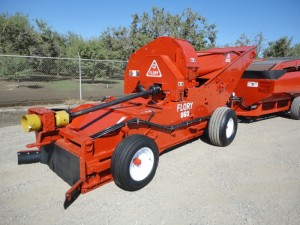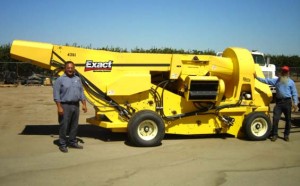
For about a month every year, Valley citizens endure large dust clouds during the annual almond harvest. Dust coats cars, sidewalks, homes—everything. Those with allergies correlate their suffering with the dust. Outbreaks of Valley Fever in the southern part of the Valley are believed to be associated with dust carrying fungi.
Almond harvesters presently blow air into almond piles to remove dust; the dust is blown away and then drifts throughout the valley.
With the thousands of acres of new almonds, we can anticipate increasing dust problems every harvest unless new dust reducing machines are acquired by companies that do custom harvesting.
Local Companies Manufacture the Solution
Two companies in Stanislaus County manufacture almond blowers that reduce dust generated by the previous generation of machines. The Exact Company is based in Modesto, while Flory makes its machines in Salida.
The Exact Company employs 80 people. Spokesperson Jason Bayer says that his company’s machines reduce dust by 75 percent. The larger almond production companies are gradually switching to the new machines, which also produce much lower diesel pollution. Absent government incentives, Mr. Bayer says that it will probably take a long time for all custom harvesting companies to upgrade to his cleaner machines; most wait until the older machines wear out.
Mr. Bayer says that his company has been working with the air district, but that progress has been slow in the promotion of cleaner technology.
Should Government Become Involved?

The San Joaquin Valley Air Pollution Control District (SJVAPCD) does not presently have a political mandate to eliminate dust during the almond harvest. Agriculture is the lynchpin of the Great Valley economy. Politicians don’t want to do anything to hamstring the industry. Anti-government sentiment makes additional regulation politically unwelcome.
Logically, any modest cost effective improvement in technology that can help clean the air should be implemented. Although the almond harvester is used only one month a year, use of the new dust reducing technology would result in significant air quality improvement during the harvest.
If additional regulation is not politically feasible, then financial incentive would be a viable alternative. Presently, SJVAPCD offers various incentives for the acquisition of electric vehicles and lawnmowers. The air district could offers incentives for using dust reducing harvesters. Many farmers would welcome dust free machines; as good stewards of the land, they don’t want valuable top soil blowing away during the harvest.
Financial Incentives
Valley residents presently pay an annual surcharge of $12 on their motor vehicle registration fees because clean air standards are not being met. The surcharge was imposed by the Environmental Protection Agency (EPA) as a financial penalty on the region for failure to adequately clean the air.
The money raised from the surcharge is returned to the valley by the EPA in the form of grant money which is used to fund various incentives that reward citizens for using cutting edge technology to reduce air pollution. The clean diesel program is one very successful example of a worthwhile incentive. The air district could apply for additional grants to fund subsidies to purchasers of dust reducing harvesters and other farm equipment.
Stanislaus County Supervisor Bill O’Brien is Stanislaus County’s representative to the SJVAPCD. If readers think that using low dust almond harvesters with cleaner diesel is a good idea, they should contact him and ask that he discuss incentives at air district board meetings.
